Microsoft Outlook vs Gmail: Why Deciding on an Email Service Matters
Let's cut through the noise. This isn't about which one has the fancier look or more users you know in your network. It’s about which platform delivers the features, security, cost, and user experience that should all fit into your lifestyle and work.
We're going to break down both platforms and do a full-blown comparison—from the price tag to the AI applications that shape how we now work.
By the end, hopefully, you'll know exactly which corner to stand in.
📌 A quick note: Everything in here has been checked and updated for November 2025. The tech world moves at a breakneck pace, so we’ve made sure the pricing and features are current as of November 2025.
Pricing: Outlook vs Gmail for Business
Let's get straight to the dollar figures.
If you’re wondering, “Does Outlook cost money?” Both Gmail (via Google Workspace) and Outlook (via Microsoft 365) have free versions that are fine for personal use.
But for business (and especially if you have a team), you’ll likely need the paid plans. Here’s how they stack up.
| Google Workspace (How much is Gmail for business?) | Microsoft 365 (How much is Outlook email for business?) | |
|---|---|---|
| Entry-Level Business | Business Starter: $7.00/user/month paid yearly or $8.40/user/month paid monthly Cloud storage: 30 GB of secure storage in Drive per user Apps: Google Docs, Sheets, Slides, Vids collaborative content creation Features: Custom business email; Gemini AI assistant; video meetings of up to 100 participants; Google Vids AI-powered video creator and editor Security and compliance features: Security and management controls, including 2-step verification, group-based policy controls, advanced protection program, and endpoint management | Business Basic: $6.00/user/month paid yearly or $7.20/user/month paid monthly Cloud storage: 1 TB per user Apps: Web and mobile versions of Word, Excel, PowerPoint, and Outlook; 10+ additional apps (including Bookings, Planner, Forms) Features: Custom business email; chat, call, and meet with Microsoft Teams; secure AI chat powered by the latest large language models Security and compliance features: Advanced identity and access management for up to 300 users; automatic spam and malware filtering |
| Mid-Tier Business | Business Standard: $14.00/user/month paid yearly or $16.80/user/month paid monthly Cloud storage: 2 TB of secure storage in Drive per user Apps: Google Docs, Sheets, Slides, Vids collaborative content creation Features: Custom business email; eSignature with Docs and PDFs; Gemini AI assistant; NotebookLM with expanded access to features; video meetings of up to 150 participants with noise cancellation and recording; Google Vids AI-powered video creator and editor; Google Workspace Migrate tool for data migration Security and compliance features: Security and management controls, including 2-step verification, group-based policy controls, advanced protection program, and endpoint management | Business Standard: $12.50/user/month paid yearly or $15.00/user/month paid monthly Cloud storage: 1 TB per userApps: Web and mobile versions of Word, Excel, PowerPoint, and Outlook; 10+ additional apps (including Bookings, Planner, Forms) Features: Custom business email; chat, call, and meet with Microsoft Teams; secure AI chat powered by the latest large language models; webinars with attendee registration and reporting; collaborative workspaces to cocreate using Microsoft Loop; video editing and design tools with Microsoft Clipchamp Security and compliance features: Advanced identity and access management for up to 300 users; automatic spam and malware filtering |
| Premium Business | Business Plus: $22.00/user/month paid yearly or $26.40/user/month paid monthly Cloud storage: 5 TB of secure storage in Drive per user Apps: Google Docs, Sheets, Slides, Vids collaborative content creation Features: Custom business email; eSignature with Docs and PDFs; Gemini AI assistant; NotebookLM with expanded access to features; video meetings of up to 500 participants with attendance tracking, noise cancellation and recording; Google Vids AI-powered video creator and editor; Google Workspace Migrate tool for data migration Security and compliance features: Secure LDAP, enhanced security and management controls including 2-step verification, group-based policy controls, advanced protection program, and advanced endpoint management | Business Premium: $22.00/user/month paid yearly or $26.40/user/month paid monthly Cloud storage: 1 TB per user Apps: Web and mobile versions of Word, Excel, PowerPoint, and Outlook; 10+ additional apps (including Bookings, Planner, Forms) Features: Windows 11 Pro upgrade, Custom business email; chat, call, and meet with Microsoft Teams; secure AI chat powered by the latest large language models; webinars with attendee registration and reporting; collaborative workspaces to cocreate using Microsoft Loop; video editing and design tools with Microsoft Clipchamp Security and compliance features: Advanced identity and access management for up to 300 users; automatic spam and malware filtering; enterprise-grade device and endpoint protection; enhanced cyberthreat protection against viruses and phishing attacks; discovery, classification, and protection of sensitive data |
📌 The verdict: It's a dead heat for the highest-tier business plans. And while Google Workspace is slightly more expensive than Microsoft, it’s probably the added storage that you’ll be paying extra for.
In fact, storage seems to be where the main difference lies—Google Workspace offers more cloud storage from its mid-tier plan, while Microsoft offers the same across the board, but with more bang for your buck at the entry-level business plan.
Also worth noting is that Microsoft, while it offers solid data security regardless of plan, you can only get the more advanced, enterprise-grade protection at the highest tier.
Features: How Do You Prefer To Work?
An email client is more than just a place to send and receive messages. It’s an ecosystem. Here’s the difference between Outlook and Gmail in terms of features.
| Feature | Gmail (Google Workspace) | Outlook (Microsoft 365) |
|---|---|---|
| Email organization model | Uses labels and filters for flexible, non-linear organization | Relies on traditional folders and rules for categories and hierarchical organization |
| Search capabilities | Advanced search powered by Google with AI-assisted suggestions, with filters and chips for more precise results | Search functionality is available through the search bar or filter menu in your inbox, but less intuitive compared to Gmail's advanced search |
| Collaboration tools | Seamless integration with Google Docs, Sheets, Slides, Drive, Meet, Chat, and real-time collaboration | Collaboration through shared documents and Teams, but often desktop-app dependent |
| Offline access | Gmail offers offline mode via browser settings, allowing access to recent emails, and syncing in Drive | Outlook provides robust offline access through its desktop application, coupled with offline caching |
| Integrations / add-ons | Extensive integrations with Google Workspace apps and third-party add-ons via Google Workspace Marketplace | Integrates deeply with Microsoft Office apps and supports add-ins through the Microsoft Store |
| Mobile / web UI consistency | Consistent and user-friendly interface across web and mobile platforms | Mobile and web interfaces are functional but can feel less streamlined compared to Gmail |
| Automation / rules | Offers filters for automatic email sorting, archiving, and labeling | Advanced rule-based automation with Rules, Flow / Power Automate, and macros |
📌 The verdict: This comes down to personal preference. Do you prefer the minimalist way Google presents its features, or the traditional, all-too-professional look that can be found in Outlook? Do you find yourself using more of the search functions or organization?
Essentially, if you like a minimalist feel and trust in search, Gmail is for you. If you need a robust, all-in-one command center and love meticulously organized folders—not to mention the powerful offline access features, Microsoft is the clear choice.
💡 No matter if you’re team Gmail or backing Outlook, email clutter is the productivity killer we all face. Clean Email steps in to tidy up, archive, and sweep away distractions.
Its Unsubscriber tool helps you step away from newsletters you no longer need, either one by one, or in bulk.
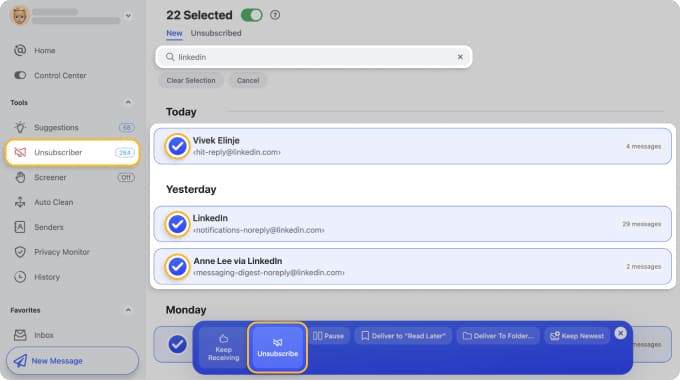

Cleaning Suggestions point out areas that could use attention. And advanced filters combined with bulk actions let you delete, move, or label large groups of messages in seconds. Voila—you’ll miss fewer emails, reply faster, and stay laser-focused.
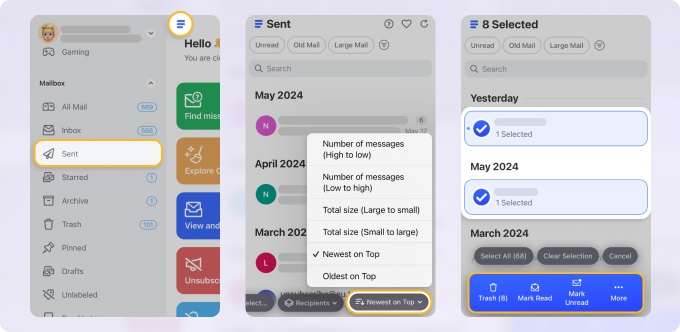
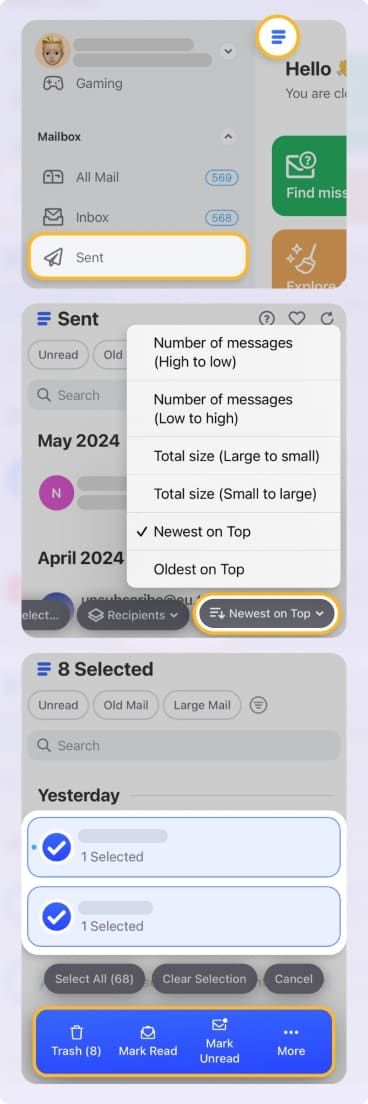
If you’re still deciding between Gmail or Outlook, adding Clean Email to the mix ensures your inbox—and your workflow—stays smooth, spotless, and stress-free. What’s best, it’s available on macOS, iOS, Android, and the web, so you can keep your email organized and efficient on any device.
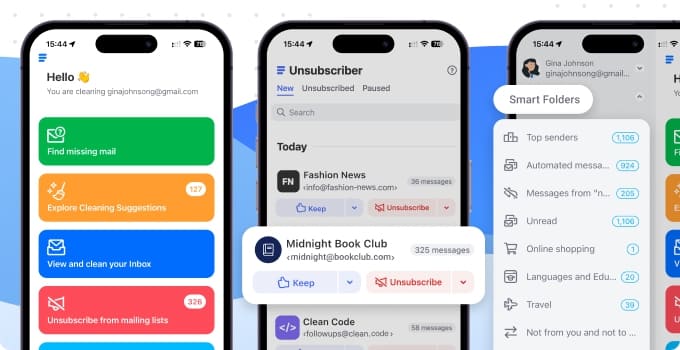
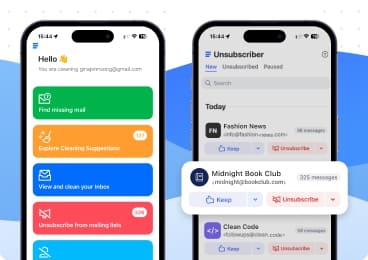
AI & Automation: Which Robot Assistant Do You Prefer?
Both Microsoft and Google are injecting AI directly into your inbox (and their entire tech stack) to make things much easier. Here’s how.
Google’s Gemini
Gemini is Google Workspace’s answer to the AI world. It’s a solid tool that’s great for brainstorming, research, and even tackling tedious admin tasks. Suffice to say, it’s the tool you didn’t know you desperately needed.

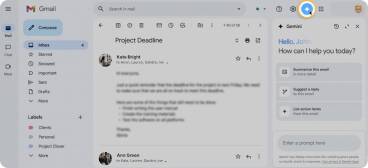
Personally, I find that it’s integrated so seamlessly into Google Workspace that, to be honest, I don’t even notice Gemini in Gmail sometimes. I’m talking about those times when I see summaries of a long email thread, right on top of the thread. That’s AI doing the hard work.


Here are other ways Gemini shows up:
- Analyze data: In Google Sheets, Gemini’s “Help me analyze” feature turns raw numbers into clear insights, complete with interactive charts. No need to be a spreadsheet wizard, nor do you need to be a martyr sitting in a bleak corner, drowning in data.
- Creative support: From generating visuals in Google Slides to creating polished videos in Vids, Gemini helps you bring your ideas to life.
- Doing the tedious, boring tasks: Workspace Flows automates multi-step processes like chasing approvals or sorting customer support tickets. Just describe what you need in plain English, and Workspace Flows takes care of the rest. Don’t worry—no coding required.
- Minutes of the meeting, AI-style: Gemini can summarize what you missed from a meeting. Need to keep track of a group chat? Just tag @gemini, and it’ll pull out the key points, decisions, and next steps.
Copilot
Think of it as your personal assistant that never takes a sick day. Copilot is built into Microsoft 365 apps like Outlook, Word, and Excel, and it’s here to handle the nitty-gritty so you can focus on the big stuff. Here’s what it can do:
- Draft emails and replies: Struggling to find the right words? Copilot can whip up a polished email draft in seconds, in your own preferred tone. Doesn’t matter if it’s a quick thank-you note or a detailed proposal, Copilot can do the heavy lifting.
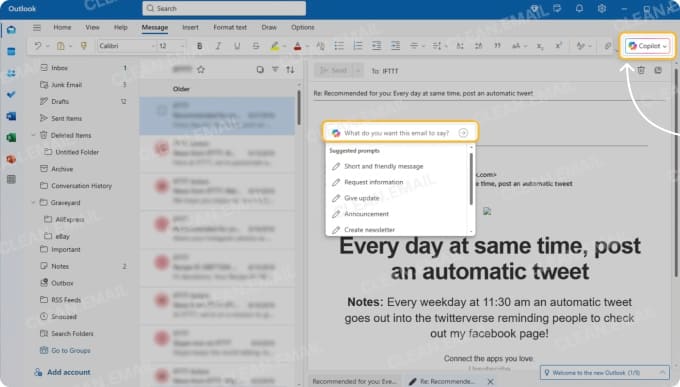
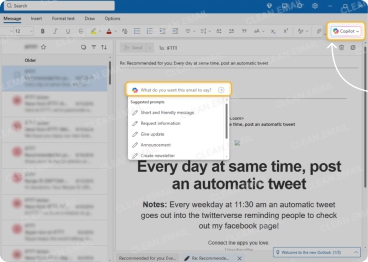
- Organize your inbox: Copilot can help you keep a tidy inbox, thanks to smart sorting and tagging. It can prioritize important emails and filter out the junk (just the same way that Clean Email can do this for you).
- Simplify scheduling: You can forget the back-and-forth on dates and availabilities. Copilot looks into your calendars to find the best meeting times. It can even send out invites with suggested agendas. I told you it’s a personal assistant!
- Automating the time-wasters: From processing invoices and summarizing emails to managing customer queries, AI-powered tools like Power Automate optimize workflows across your business.

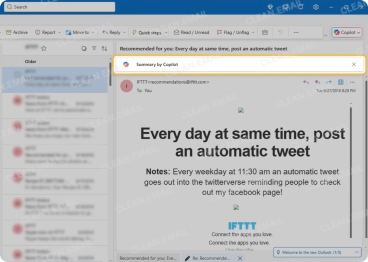
- Data-driven decisions: With AI, Microsoft turns mountains of data into actionable insights. Whether you’re forecasting sales, analyzing customer behavior, or planning your next big project, tools like Dynamics 365 and Power BI help you make decisions backed by real-time data.
📌 The verdict: Gmail and Outlook are flexing their AI muscles with tools that summarize threads, suggest replies, and draft messages. For individual users and small teams, Gemini might feel more intuitive. For large organizations, Copilot’s deep integration is a game-changer, excelling at enterprise-level tasks by leveraging data across the entire Microsoft 365 ecosystem.
But here’s the catch: even the smartest AI is only as sharp as the inbox it’s working in. A cluttered inbox full of irrelevant threads, unread newsletters, and outdated messages can leave your AI spinning its wheels—or worse, making stuff up.
💡 Clean Email is a silent worker, keeping your inbox under control without getting in the way. It’s Auto Clean handles routine tasks automatically while working quietly in the background, so you do not have to manage the same clutter over and over again.
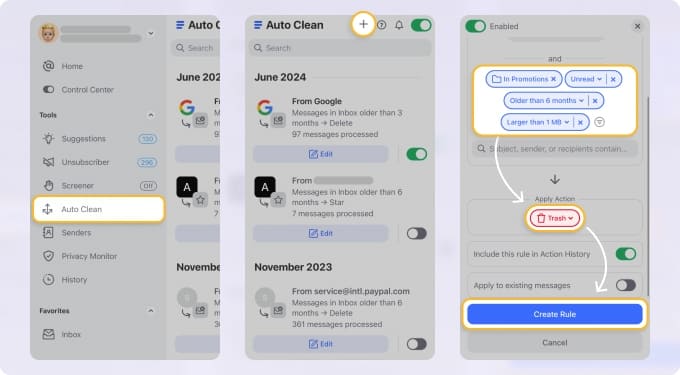

Smart Folders group related messages on their own, and the Screener tool keeps new senders, with the unwanted ones included, from ever reaching your inbox before you choose to allow or block them.
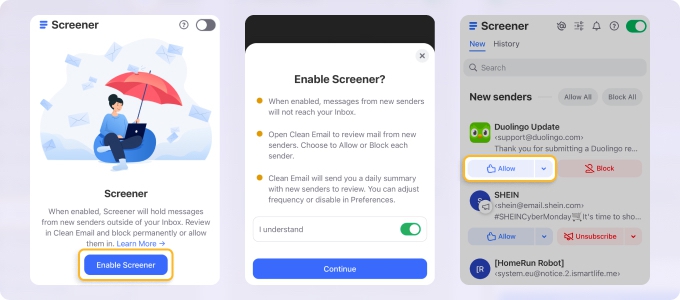

And because of that, your platform’s AI tools can finally hit their stride, delivering smarter, sharper, and more spot-on suggestions. Clean Email doesn’t compete with AI—it clears the way for it to do its best work.
Outlook vs Gmail Security, Admin & Compliance
Security isn’t really optional. A breach can be catastrophic for a business or a major headache for you as an individual. Here’s how Gmail and Outlook can help you stay secure online.
- Gmail blocks over 99.9% of spam and phishing attacks before they even hit your inbox. It offers essentials like 2-Step Verification and Confidential Mode (emails that expire). For businesses, Google Workspace provides solid tools like data loss prevention (DLP) and security sandboxing to vet attachments.
- Outlook leverages Microsoft's enterprise security legacy. With Microsoft Defender for Office 365, it provides real-time protection against sophisticated threats. Features like Safe Links and Safe Attachments scan everything before you can click on it. For businesses in regulated industries, its encryption and compliance tools are more granular and robust.
📌 The verdict: Both platforms offer top-tier security for the average user. For businesses with strict compliance needs or those handling highly sensitive data, Microsoft 365’s advanced security suite (especially on the premium plans) offers a more granular and powerful set of tools.
Is Outlook or Gmail Better? Use Cases for Businesses
Is Gmail or Outlook better for business? Why do companies use Outlook instead of Gmail (at least traditionally)?
We don’t know for sure. But let’s just say we can list a few scenarios of when a business is more likely to benefit from Outlook or Gmail (although this is by no means definitive—just trying to paint a picture, really!)
Go with Gmail & Google Workspace if your business is:
- A fast-moving startup or small-to-medium business that lives in the cloud, and lives for a minimalist and intuitive interface.
- A team of writers and editors heavily relies on collaboration, co-editing documents in real-time.
- A small photography business is looking for a cost-effective solution with massive amounts of cloud storage.
Go with Outlook & Microsoft 365 if your business is:
- An established enterprise has deep roots in the Microsoft ecosystem and is super reliant on the powerful, feature-rich desktop versions of Word, Excel, and PowerPoint.
- A medium-sized business is operating in a regulated industry where advanced security, compliance, and data governance are non-negotiable.
- A sales-oriented business consists of power users who need a unified hub to manage complex schedules, multiple inboxes, and task lists.
The Final Recommendation: The Choice is Yours
The "better" email service doesn't exist. The right one for you depends entirely on how you work.
➡️ Choose Gmail if you love apps like Drive, Docs, and Google’s ecosystem that’s minimalist in look but packed with features.
➡️ But go for Outlook if you think your work revolves around the Microsoft Office desktop apps and you work in a larger organization with a need for advanced security and compliance controls. Let’s not forget the fact that the Outlook cost per user is worth it when you’re a power user who wants a robust, all-in-one desktop command center.
Ultimately, both are fantastic services. The best advice? Take advantage of the free trials and spend some time using them to see which one clicks with your workflow.
But no matter which one you choose, ensuring a clean and tidy inbox can make your workflows even smoother — and Clean Email can help you get there.


